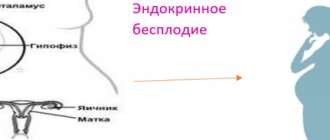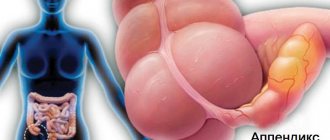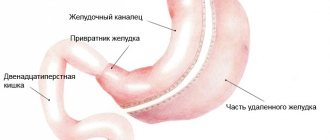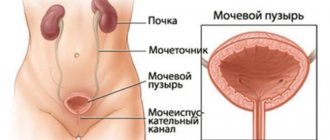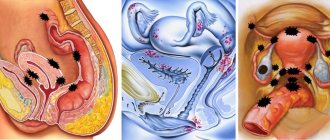When creating a family, each couple assumes the possibility of procreation - the birth of children and their upbringing. But a year or two passes, and pregnancy still does not occur. If a couple has been having regular sex life all this time and does not use any contraceptives, then after this period certain anxieties and worries appear about the possibility of conceiving a baby. There may be two reasons for this, and both of them relate to health - the health of a man and the health of a woman who wants to give birth to a child.
Let’s leave the topic of male reproductive health for a moment and talk about women’s.
According to medical statistics, in recent years there has been an increase in cases of infertility among girls who have reached reproductive age. Probably, for every girl, finding out about her inability to conceive and give birth to a child is the worst thing that can happen in life. A diagnosis of infertility does not allow you to experience the joy of motherhood. And for many women, the absence of a child means a broken family.
In this regard, it is very important to know the signs of possible infertility in a girl. This will allow for a timely, comprehensive examination, to prescribe and carry out the necessary treatment and medical procedures to reactivate the reproductive capacity of the female body.
What can cause infertility?
There are a number of reasons the presence of which can prevent pregnancy, pregnancy and the birth of a child:
- Hormonal dysfunctions, manifested by impaired functioning of the ovaries and other organs responsible for the production of hormones - the pituitary gland, hypothalamus, adrenal glands and thyroid gland. Infertility in this case is inevitable.
- Endometriosis of the uterus. This disease is fraught with the formation of scars. If signs of this disease are noticed in the internal organs of the patient’s reproductive system, then infertility should be feared.
- Symptoms of infertility can also include pathological changes in the uterus - such as polyposis, fibroids, bicornuate uterus or the presence of an intrauterine septum. All these pathologies can be congenital, but they can also arise during life.
- Blocked fallopian tubes - tubal infertility. It occurs due to the formation of adhesions in the fallopian tubes.
- The presence of adhesions in the pelvic area. Such adhesions can form as a result of any inflammation or surgical intervention. Such adhesions can occur between the fallopian tube and the ovary, making it impossible for the egg to enter the uterus for fertilization.
- Chromosomal pathology. This is a rather rare pathology, but, nevertheless, it leads to the woman’s sterility.
- Immunological factor. This type of infertility is also quite rare. With this type of disorder, a woman’s reproductive system produces antisperm bodies that prevent sperm from penetrating into the uterus, making fertilization of the egg impossible.
- Psychological factor. There are two reasons for this case - fear of pregnancy and childbirth; reluctance to have a child from a specific sexual partner.
Types and degrees of infertility
There are two types of infertility - absolute and relative.
Absolute infertility is the most terrible type of infertility, which has no cure. This type of infertility is caused by improper development of the human body, for example, in the complete absence of any reproductive organ or part of it (uterus, ovaries).
Relative infertility is not irreversible and after certain measures can be successfully overcome, which in turn will allow you to lead a normal life and have healthy offspring.
In addition to the types of infertility, there are also two degrees of infertility:
- primary infertility (first degree) - occurs in girls who have never been pregnant in their lives;
- secondary infertility (second degree) - occurs in women who were pregnant and may already have a child, but currently have certain problems with conception. This type of infertility is diagnosed in approximately 45% of women, who, as later confirmed, have various gynecological diseases, which usually result in the formation of adhesions. Often, the ability to conceive is influenced by previous operations on the internal genital organs (including induced medical abortions).
Types of infertility
The scientific name for female infertility is infertility (from the Latin infertilis - infertile). A woman is given such a terrible diagnosis if, during a year of regular sexual intercourse, she cannot become pregnant or bear a child (miscarriage occurs).
There are several types of female infertility:
- primary infertility;
- secondary;
- absolute infertility;
- relative.
The primary type of female infertility is infertility in a woman who has not previously given birth. According to statistics, this is due to her endocrine system, which is not working properly. Possible hormonal imbalance.
Secondary type – infertility in a woman who has previously given birth. Also, this type of female infertility applies to those women who have had a miscarriage. In case of secondary infertility after the birth of the first child or miscarriage, a second pregnancy does not occur. Basically, in 85% of cases, the causes are diseases of the genital organs.
The diagnosis of absolute infertility is made to a woman who does not have fallopian (fallopian) tubes or a uterus.
Temporary (another relative name) infertility in a woman means that there are factors preventing pregnancy. This type of infertility very often occurs in women who have previously had an abortion.
Signs of infertility
The first symptoms of the possible development of infertility appear in girls even in puberty (during puberty), and these include the following signs:
- congenital disorders and dysfunctions of the girl’s genital organs;
- late onset of menstruation - menarche at a very late age (after 16 years);
- scanty menstrual flow;
- long (long) menstrual cycle;
- irregular monthly bleeding;
- chronic diseases;
- nervous system problems;
- infectious diseases of the reproductive system.
You should pay attention to the girl’s physical development. If she is noticeably behind (severe thinness - up to 45 kg) or ahead (overweight - over 90 kg) in the development of her peers, then in the future this can lead to infertility.
More on the topic
Causes and signs of infertility in women and men
Treatment of infertility in women
Signs of infertility in women
Symptoms of infertility in women
Can ureaplasma cause infertility?
The very first sign of infertility may be destabilization of the menstrual cycle. The discharge can be either scanty or abundant, often irregular and often very painful.
There are also a number of minor external manifestations:
- increased oily skin, acne are symptoms of the presence of an increased amount of male hormones;
- thick hair on the face, chest, midline of the abdomen, bikini area, thighs and legs, forearms;
- insufficient hair growth in the armpits and pubic area is evidence of low estrogen concentration, and this may affect the possibility of conception;
- the appearance in the body of the hormone prolactin (responsible for milk production in women during breastfeeding) can suppress the formation of eggs in the body. If a woman is not pregnant, but milk is released from her breasts, problems may arise with conception.
The combination of various causes and external signs of infertility helps gynecologists determine the root cause in order to prescribe the correct treatment. For example:
- in the absence of menstruation (ovulation) and severe obesity, polycystic ovary syndrome can be assumed;
- Due to endometriosis, women experience painful periods.
Causes of female infertility
Around age 36, a woman's ovaries begin to produce fewer eggs. This means that it will become more difficult to get pregnant, and the likelihood of congenital pathologies in the child also increases.
Insulin resistance is one of the most common causes of female infertility. This happens due to the fact that metabolism in the female body is disrupted due to excess of the normal level of insulin in the body. The adrenal glands begin to produce more insulin than needed. For this reason, a hormonal imbalance occurs in the female body; male hormones begin to be produced in large quantities.
Here are the main causes of female infertility:
- Age.
- Bad habits.
- Excess weight or lack thereof. If a woman is overweight, this may mean there is a hormonal imbalance. This hormonal imbalance is one of the causes of female infertility.
- Frequent stress. At times of severe stress, the hormone prolactin begins to be produced in very large quantities, and the hormonal balance is disrupted.
- Exceeding the norm of the hormone prolactin. If the norm of this hormone is exceeded, it can affect the production of substances by the pituitary gland that are necessary for the successful fertilization of the egg.
- Blocked or very poor patency of the fallopian (fallopian) tubes. If the tubes are blocked, sperm will not be able to reach the egg to fertilize it.
- A woman cannot bear a child. It happens that fertilization is successful, but then a miscarriage occurs as a result of a malfunction in the body (genetic disorders, hormonal, etc.).
- Chlamydia. This is a sexually transmitted infectious disease.
- Polycystic ovary syndrome. This is a common chronic female disease. The cause of the disease is a change and abnormal structure of the gonads. With this disease, hormonal levels are disrupted and ovulation is absent.
- Uterine fibroids are benign formations in the uterus. If a woman is diagnosed with uterine fibroids, this means that the chances of successful conception are reduced. Even if conception occurs, there is a high probability of miscarriage.
- Spikes. Adhesions in the pelvic area can lead to infertility. Such adhesions appear as a result of previous operations or inflammation. It is more difficult for sperm to reach the egg due to adhesions in the pelvic area.
- Endometriosis – with this disease, the mucous membrane (endometrium) of the uterus greatly enlarges. With endometriosis, the fallopian tubes can become sticky and block access for sperm to the egg.
Be sure to watch this very useful video:
Diagnosis of infertility
The process of diagnosing infertility, as a rule, begins with a gynecologist interviewing the patient. During the conversation, the doctor establishes the start date of the first menstruation, then their frequency, duration and the absence or presence of painful sensations during menstruation, and possible discharge from the mammary glands.
The next point of the survey will be information about the presence and number of previous pregnancies and the nature of their course (how the pregnancy proceeded - the presence of pathologies; how it ended - childbirth, abortion, miscarriage).
In addition, the doctor will ask about hereditary diseases, as well as whether there have been infections of the genitals (sexually transmitted diseases).
When a patient first contacts a gynecologist with complaints about difficulties conceiving, the doctor prescribes a urine test, which determines the concentration of sex hormones (estrogen and progesterone), and also diagnoses the presence of sexually transmitted infections.
There are a number of special techniques and tests to accurately determine infertility:
- determining the concentration of the hormone estrogen in a woman’s body;
- establishing internal body temperature - performed (with a rectal thermometer) to diagnose ovarian dysfunction and the absence of their ovulatory phase;
- test to determine the presence of antisperm bodies (for the viability of sperm in the cervix).
If adhesions are detected in the internal genital organs, colposcopy is used for diagnosis.
When identifying endometriosis (a fairly common cause of infertility), curettage of the inner surface of the uterus and hysteroscopy can help. This operation is usually performed under general anesthesia. During the operation, the inner surface of the uterus is examined, and a small sample of endometrial cells is taken for laboratory testing.
Causes and symptoms of infertility in women
Content:
What is infertility?
Infertility in women (female infertility) is the inability to conceive within a year of regular penetration of viable and active sperm, naturally or artificially, into the reproductive organs of a woman of puberty. The diagnosis of infertility is also made if the pregnancy always ends in miscarriages. Up to 20% of couples are infertile.
Infertility in women should not be confused with failure to carry a pregnancy to term, when a mature oocyte is successfully fertilized by a sperm, but the pregnancy ends, at the embryogenesis stage, with a miscarriage or abortion.
A woman is not considered infertile if her partner has non-viable, weak sperm or no sperm at all.
Infertility problem. The problem of infertility is now much more serious than it was before, several centuries ago. The sexual revolution carries a serious responsibility, if only because it spreads infectious diseases. And young people increasingly do not want to have children, delaying pregnancy is increasingly increasing. If we take all infertile couples as 100%, then in 33.3% the man is infertile, in another 33.3% the woman is infertile, and in the remaining couples, both partners are infertile.
The causes of infertility can be defects in the development of the reproductive system, dysfunction of the genital organs, severe intoxication and general diseases of the body, as well as mental and neurological disorders. Infertility does not belong to the group of independent diseases; it always appears as a result of various diseases of the body. The main cause of female infertility is inflammatory diseases.
Physiology of monthly cycles
Infertility can occur with disrupted and normal monthly cycles. A woman's natural monthly cycle lasts 21-35 days and consists of three consecutive phases.
1. Follicular phase - maturation of the egg (no less than 7 and no more than 22 days)
2. Ovulatory phase of maturation and release of a mature oocyte, the onset of the fertile period.
3. Luteal - phase of the corpus luteum, catabolism (from 13 to 15 days).
The few days before and after ovulation are called the fertile period (phase) - this is the time of greatest likelihood of conception. Until this moment and after, pregnancy cannot occur! However, we must understand that for different women this phase occurs at different periods of menstruation. If the cycle is not resolved by pregnancy, then the body, under the influence of estrogens, prepares for the next cycle.
Classification of infertility
Infertility may be:
- primary – pregnancy has never occurred (congenital gynecological anomalies) or (complications on the female genital organs) before or after menarche (first cycle);
- secondary, after the first successful pregnancy, the impossibility of repeated fertilization can be absolute (incurable) or relative (curable).
In some sources devoted to research into the physiology and pathophysiology of the female reproductive system, the concept is supplemented by the following types of infertility.
- Physiological. The norm is infertility at an early age (before puberty), and postmenopausal infertility (after menopause).
- Voluntary. Another name for consciously chosen infertility is the use of (medicinal) drugs or physical (coil, other) means.
- Temporary. It may be the result of prolonged stress, weakening of the body after or during the period of illness; some authors classify temporary infertility as lactational amenorrhea - inhibition of ovulation in the early period of regular breastfeeding.
- Constant. Removal of the female genital organs, complete or partial, is the result of surgery.
Signs and symptoms of infertility in women
An important sign indicating infertility in a woman is the inability to become pregnant for a year or more, in the presence of favorable conditions for conception, namely:
- regular sexual intercourse;
- sexual partner with a good spermogram;
- complete, long-term refusal of contraception;
- The woman's age is from 20 to 45 years.
Infertility does not have a pathognomonic (leading) sign, and is often asymptomatic or has indirect symptoms. Signs of infertility are established by collecting anamnesis, examination, physical, laboratory, and instrumental studies.
Anamnesis. Obvious symptoms associated with disruption of regular cycles are established: long, short, painful, heavy, with foreign secretions. Infertility can be assumed based on the establishment of indirect symptoms characteristic of infectious, non-infectious and surgical diseases.
Physical examination
During physical examinations in the clinic, possible signs of infertility are:
- body mass index less or more than 20-26;
- skin condition and derivatives with signs of endocrine disorders;
- unsatisfactory degree of development of the mammary glands;
- signs of pain, compactions in the projection of the woman’s pelvic organs, during bimanual gynecological palpation;
- signs of gynecological diseases are revealed during examination of the cervix, using a vaginal speculum, or colposcopy.
Laboratory and instrumental methods
Signs that may indicate infertility are established in the process of laboratory and instrumental studies, with:
- infectious screening for STIs;
- hormonal screening to exclude endocrine infertility;
- Ultrasound of the female pelvic organs, thyroid gland – hormonal infertility;
- hysterosalpingography (HSG) – radiographic exclusion of symptoms of fallopian tube obstruction;
- MRI for brain tumors (sella turcica) that inhibit the production of hormones that regulate monthly cycles;
- spiral computed tomography (SCT) of the pelvic organs - anatomical causes of infertility;
- laparoscopy (visual examination of the abdominal organs) – tubo-peritoneal infertility, adhesions, uterine tumors, ovarian retention cysts;
- hysteroscopy (examination of the walls of the uterine cavity) - tumors of the uterus, inflammation, ulceration of the walls of the uterus.
Causes of infertility in women
Women's infertility is caused by many private reasons (factors). The reasons are not always obvious. In some cases, they cannot be diagnosed or are combined with each other, increasing the negative effect on the female body.
If we summarize the known causes (factors) of infertility, there are several large groups of causes of infertility:
- Congenital anomalies of the reproductive organs.
- Acquired, causing in the reproductive organs:
- anatomical and morphological changes;
- functional disorders;
- metabolic imbalance.
The above describes most of the private (specific) causes of female infertility. It has been noted that in women over 35 years of age, especially those who have not given birth before, the risk of infertility increases.
There are two common causes of decreased fertility that are not related to previous gynecological diseases:
- age-related slowdown of physiological processes;
- long-term use of contraceptives.
Infertility from contraceptives
In the literature there are opposing opinions regarding the use of hormonal contraceptives. Proponents argue the benefits of birth control due to the “rebound effect” after stopping hormonal contraceptives. That is, the abolition of factors that inhibit the fertilization process stimulates a sharp release of estrogens, increasing the likelihood of becoming pregnant. In some cases this is what happens.
On the other hand, there are cases of temporary or permanent decrease in fertilization (fertilization) after long-term use of contraceptives. Obviously, the truth is in the middle. The negative effects of hormonal drugs should be avoided, based on the advice of a gynecologist, when planning your personal (marital) life. It is possible to combine various methods of contraception and then they will not be one of the causes of infertility.
Causes of secondary infertility in women
Women who have previously successfully given birth seek help in determining the causes of infertility. The inability to become pregnant again for a long time is called secondary female infertility. If we do not take into account the voluntary refusal of conception and the age factor, the most obvious causes of secondary infertility are previous diseases, including gynecological infectious or non-infectious etiopathogenesis.
Factors of infertility
Infertility almost always has many causes (factors). As a result of research and clinical observations, it has been established that infertility factors are structured (grouped) based on the combination of homogeneous characteristics, according to:
- anatomical localization of the pathogenesis of diseases that cause infertility;
- the nature of pathophysiological processes in the body (endocrine disorders, the phenomenon of immunological rejection of germ cells);
- genetic abnormalities that prevent fertilization;
- peculiarities of the psychosomatic state of women of fertile age in different living conditions;
- influence of male factor infertility.
Cervical factor infertility
For successful fertilization, at least 10 million active sperm must enter a woman’s uterus. The vaginal environment of a healthy woman is a barrier to any agents foreign to the female body, including sperm. With vaginitis, the causes of death of sperm in the vagina are associated with pathological processes. The normal environment is not an absolute barrier for sperm; active cells move to the cervix, which is covered with mucus. The mucus on the walls of the cervix is produced by epithelial cells.
The ability of sperm to penetrate cervical mucus depends on:
- sperm activity and motility;
- physicochemical characteristics of cervical mucus.
With pathologies, the properties of mucus change, becoming an insurmountable barrier even for active sperm. The inability of male reproductive cells to cross the cervix is called cervical factor infertility.
Cervical infertility factor (change in mucus viscosity and other properties) can be the result of:
- hormonal disruptions in the production of female sex hormones;
- inflammatory processes in the cervix;
- disturbed microflora on the mucus of the cervix.
Tubal factor infertility
The fallopian tubes transport a mature egg from the ovary to the uterine cavity. The mucous membrane of the fallopian tubes is lined with ciliated epithelium.
The movement of the egg occurs as a result of:
- peristaltic movements of pipe walls;
- flickering of the cilia of the epithelium, creating the flow of tubular fluid
Damage to the cilia provokes pathological fixation of the egg in the tube, creating a risk of ectopic pregnancy. The greatest negative impact is associated with complete or partial obstruction of the tubes for a mature egg - this is the tubal factor of infertility.
Obstruction (obstruction) of the fallopian tubes can be:
- in the area of the funnel - the distal (far) part of the fallopian tubes;
- in the area of the fallopian tubes (proximal or proximal) of the fallopian tubes;
- along the entire length (obstruction of the infundibulum, ampulla, isthmic and uterine sections) of the tubes.
Establishing the types of obstruction is of diagnostic importance:
- partial;
- complete.
Tubal obstruction - a factor of infertility can be caused by spasm or blockage of the lumen of the tube as a result of inflammatory adhesions, tumor growth, or other reasons. A disease of the fallopian tubes, accompanied by obstruction of the tubes and the accumulation of transudate (fluid) in their lumen, is called hydrosalpinx.
Typical causes of hydrosalpinx are complicated inflammation:
- fallopian tubes – salpingitis;
- fallopian tubes and ovaries – salpingo-oophoritis;
- fallopian tubes, ovaries and ligaments - adnexitis (inflammation of the appendages).
An obstacle in the path of the egg may be accompanied by pain in the abdominal area. To diagnose hydrosalpinx, X-ray examination (hysterosalpingography) and/or laparoscopy (a special type of examination of the abdominal cavity) is used.
Cervical factor infertility
A through hole - the pharynx in the center of the cervix, like a sluice, connects the uterine cavity and the vagina. The function of the gateway, the pharynx of the cervical canal, manifests itself in the form of periodic:
- inaccessibility of the uterus, most of the time, to foreign agents, including sperm;
- accessibility of the uterus for active sperm seeking to fertilize a mature egg.
The function is provided by the mucus of the cervical canal, which, under the influence of estrogens, changes its physicochemical and rheological (viscosity) properties at different periods of the monthly cycle.
- During the period of greatest likelihood of fertilization, the mucus changes properties, for example, the pH from acidic to favorable for sperm - neutral and slightly alkaline and becomes less viscous.
- During the inactive phase of the cycle, mucus from the throat provides protection to the woman’s body from pathogenic agents.
If the cervical mucus of the pharynx of the cervix, under the influence of pathological factors, is inaccessible to the penetration of sperm into the fertile phase, this is a cervical factor of infertility.
Cervical mucus in the body of a healthy woman performs the following functions:
- protection (protection) and temporary depot (storage) of sperm in the reproductive tract;
- retention of weak sperm, unable to overcome the physical barriers of viscous cervical mucus;
- transmission of sperm activation factor, increasing their motor activity;
- capacitation (ability) and acrosomal reaction (penetration) of sperm i.e. ability for sperm to penetrate the oocyte.
The external os is visually examined with a vaginal speculum. The internal os is inaccessible to conventional examination methods.
Cervical factor infertility is detected by colposcopy by detecting a “pupil symptom” in the pharynx of the cervical canal. A positive pupil sign is clear, watery periovular mucus.
Cervical factor is detected by laboratory methods:
- study of the rheological and biochemical properties of mucus;
- postcoital test (PCT) for the interaction of sperm and mucus after some time after sexual intercourse. Typically, the time for determining PCT is 9-24 hours;
- determination of the periovulatory Kurzrock-Miller test.
Laboratory tests are performed by experienced laboratory technicians. The research results depend on the correct timing of the study.
Tubal peritoneal factor of infertility
The abdominal cavity and internal organs are protected by the mesentery from contact and fusion with the abdominal wall and neighboring organs. The mesentery is a serous membrane lining the inside of the abdominal cavity, divided into:
- parietal layer of the mesentery - separates the internal organs from the abdominal wall on the inside.
- The visceral layer of the mesentery suspends all the internal organs of a person.
The abdominal cavity is filled with serous fluid, which also serves to protect organs from mutual fusion and friction. Normally, all internal organs have some degree of spatial mobility.
The fallopian tubes and uterus are suspended on the mesentery. Under the influence of pathogenic factors, adhesions form between the fallopian tubes and the mesentery or a neighboring organ.
As a result, the fallopian tubes connected to the mesentery lose:
- mobility;
- sufficient blood supply
- full innervation;
As a result of adhesions in the abdominal cavity, the fallopian tubes cease to fully perform their functions. The cessation of the functioning of the fallopian tubes under the influence of peritoneal adhesions is called tubo-peritoneal factor of infertility.
Causes of tubal peritoneal factor infertility:
- Inflammatory diseases of the pelvic organs that have progressed to the chronic stage of fibrinous inflammation (often STIs)
- Complications after abortions, operations on the pelvic organs.
Damage to the pipes leads to disruption of monthly cycles and chronic pain syndrome.
Infertility or decreased fertility of tubo-peritoneal origin is manifested by:
- obstruction of the fallopian tubes – tubal factor infertility
- adhesive process in the pelvis – peritoneal factor of infertility
- combination of tubal and peritoneal infertility
For differential diagnosis of tubo-peritoneal factor of infertility, ultrasound, laparoscopy, and echography are performed.
Immunological factor of infertility
Normally, a woman’s immune system, when foreign proteins penetrate in the form of seminal fluid and sperm (antigens), does not react by producing specific antibodies (ASAT). The reasons that result in immunological rejection of sperm are not fully understood.
The appearance of ASAT in women is likely the result of the development of rejection reactions similar to type 2 allergic reactions. The barrier properties of the mucous membranes may be impaired as a result of a decrease in the amount of mucus on the internal surfaces of the genital organs during degenerative inflammatory processes. Currently, this pathology is treated by immunocorrection methods, reducing the number of circulating antibodies, and stimulating reparative (restorative) processes on the mucous membranes of the birth canal.
Another immunological pathology is the factor of infertility, the production of antiovarian antibodies (AOA) by the female body against its own eggs. The reasons for the appearance of immune complexes that destroy one’s own immune defense are complex and are within the competence of immunologists. Like all autoimmune diseases, they can be treated in the early stages of pathogenesis. In advanced cases, the prognosis is cautious.
Endocrine factor of infertility
Hormonal imbalances lead to irregular cycles or their absence. The main causes of this type of infertility are dysfunctions:
- Consequences of traumatic brain injury, tumors of the hypothalamic-pituitary region of the brain;
- An imbalance of androgens over estrogens (hyperandrogenism) in the female body is observed when the ovaries or adrenal glands are damaged, accompanied by polycystic ovary syndrome;
- Decreased functional activity of the thyroid gland (hypothyroidism) is the cause of cycle disorders;
- An insufficient amount of estrogen, accompanied by a disturbance in the rhythm of the monthly cycles, leads to pathological damage to the mucous membrane of the birth canal;
- Lipid metabolism disorders accompanied by excess or loss of adipose tissue provoke a decrease in ovarian function;
- Hormonal imbalances accompanied by premature menopause;
- Congenital abnormalities of the hormonal system, accompanied by underdevelopment of the birth canal.
Endocrine disorders are studied in cases of disturbances in monthly cycles, against the background of external signs of endocrine disorders (obesity, exhaustion, etc.).
Psychological factor of infertility
Stress is a general adaptive reaction of the body to various stimuli; it has a complex regulatory mechanism involving, among other things, the body’s hormones. It makes no sense to look for specific causes of stress, such as psychological factors of infertility; they are individual for each woman. In general terms, sources of stress are:
- excess negative information;
- regular emotional reactions;
- physiological or pathophysiological reactions of the body.
With chronic stress, the body's adaptive defense mechanisms are depleted. Bioregulatory structures (autonomic nervous system, hormones of the adrenal glands, pituitary gland and others) stop working towards adaptation and cause pathophysiological changes in the body. The psychological factors of infertility hide pathophysiological changes in the body (including hormonal disorders). To determine the causes of psychological infertility, you should stop looking for the source of stress, you must:
- Change your attitude towards the stress factor. It has been noticed that families with a low level of education do not have problems with having children, in contrast to families where women with a high level of intelligence and social status suffer from obvious and imaginary stress. Physical exercise, healthy hobbies, relaxation, positive emotions, and so on will restore hormonal and mental balance.
- Contact a qualified psychologist. It is not always possible to overcome stress on your own. Find a specialist who will help you stop thinking about imaginary problems and help you understand the true causes of infertility.
Genetic factors of infertility
The genetic factors of male infertility are described in detail in the literature. The genetic factors of infertility in women have been little studied. There are known particular pathologies that cause female infertility and have genetic roots.
- Female hyperandrogenism syndrome (excess male hormones).
- Endometriosis (overgrowth of the walls of the uterus).
- Premature menopause syndrome.
- Primary amenorrhea syndrome (Sherevsky-Turner syndrome).
There are also other diseases accompanied by genetically determined infertility. The causes and likelihood of excluding genetic abnormalities in the future are the subject of research by geneticists. Laboratory methods for diagnosing genetic factors of infertility are currently being developed.
Degrees of infertility
The etymological meaning of the word “degree” in medicine means the magnitude of comparison of pathological processes of different intensity. The use of the term is appropriate when comparing private (specific) pathological processes in relation to a limited group of patients with a similar diagnosis. More often, in the available literature, infertility is characterized as types I and II of infertility.
1st degree infertility in women. Or infertility I is the absence of pregnancy in a woman who has never given birth before. Typically, the period of infertility is counted after one year of the beginning of regular sexual activity, without the use of contraceptives. The causes of infertility 1 are indicated above in the text (see classification of infertility).
Infertility of the 2nd degree in women. Or infertility II is the inability to conceive, refers to women who have previously had a pregnancy or given birth. The period of infertility is counted from the first attempts of repeated pregnancy. Usually also after a year. The causes of infertility II are indicated above in the text (see classification of infertility).
Infertility of the 3rd degree in women. The term characterizing the degree of inability to become pregnant is not used in the available literature.
Treatment methods
- Modern approaches to infertility treatment
- Drugs for the treatment of infertility
- Medicinal herbs for infertility
- Combined use of hogweed, red brush and sage
Recommendations for suspected infertility
Experts say that to achieve the maximum chance of fertilization, conception should be carried out from the 11th to the 18th day of the menstrual cycle. We remind you that the first day is the first day of menstruation. Men should not ejaculate more than once every 2 days, as the concentration of sperm is maintained at a maximum, only in this case. Both partners should not use lubricants. And after sex, a woman should not wash herself. In addition to all this, experts say that you need to have sex during fertilization in the “missionary” position, and after intercourse, the woman should still lie on her back for 15-20 minutes, with her knees bent and raised.
If the presented methods do not give the desired result, the couple will be prescribed treatment. In cases where it is impossible to eliminate the causes of infertility, experts recommend modern assisted reproductive methods such as IVF.
In vitro fertilization is a relatively new method of treating infertility, the essence of which is the fertilization of eggs by sperm in a test tube and the subsequent transfer of the fertilized developing egg (embryo) to the uterus. This procedure gives a good chance of pregnancy, however, it is worth choosing a clinic responsibly. The main factors influencing the choice of a clinic are the level of professionalism and experience of fertility doctors, as well as modern equipment.
Among the centers in Russia with the best reputation, one can highlight Moscow, which fully complies with the above requirements. The center has the latest innovative equipment, which allows you to significantly increase the effectiveness of the procedure. And the staff consists of highly qualified specialists who are considered one of the best in the field of IVF, including Potapov M.E., who stood at the origins of domestic reproductology. and member of the Council of the Russian Association of Human Reproduction Koloda Yu.A.
Even if a woman dreaming of a child is diagnosed with infertility, this is not yet a reason to despair! Modern medicine not only gives hope for a new addition to the family, but also proves its capabilities by the result of numerous happy families.
Author of the article: Lapikova Valentina Vladimirovna | Gynecologist, reproductive specialist
Education: Diploma in Obstetrics and Gynecology received from the Russian State Medical University of the Federal Agency for Health and Social Development (2010). In 2013, she completed her postgraduate studies at NIMU named after. N.I. Pirogova.
Our authors
Infertility treatment
Methods and measures for the treatment of reproductive disorders are prescribed only after a thorough examination and diagnosis.
The most difficult process of infertility treatment is the removal of foci of infection in endometriosis. After complete removal of such lesions, the achieved result is secured with medications.
When diagnosed with fallopian tube obstruction, surgical intervention is required. Modern treatment methods make it possible to perform the necessary operation with minimal possible harm to adjacent tissues and organs - using laparoscopy. With this method, the healing process and postoperative rehabilitation are much faster and easier.
If the cause of infertility is a failure of the endocrine system, then with the help of special pharmacological drugs the hormonal levels of the body are corrected. In this case, the patient is prescribed certain medications and the presence of hormones in the body is monitored. After normalization of hormonal levels, the ability to have children is restored.
Prevention of infertility
Without a doubt, infertility is the most serious disorder in a woman’s body, preventing her from performing the function inherent in nature - the birth of offspring. The inability to have children brings nervousness and discord into the relationship between spouses, sometimes leading to divorce. However, most women, having undergone an appropriate course of treatment, sooner or later find the joy of motherhood. To avoid such problems, there are a number of measures that, if followed, can minimize the risk of infertility in girls:
- compliance with personal hygiene rules;
- proper nutrition and avoidance of excessive dieting;
- giving up bad habits: smoking, drinking alcohol and drugs;
- avoidance of stressful situations;
- abstinence from early sexual activity;
- an orderly sex life and refusal to frequently change sexual partners;
- controlled use of contraceptives;
- exclusion of abortion.
In many cases, consciously taking care of your health allows you to prevent infertility, because eliminating the consequences of frivolous behavior and conducting a successful course of treatment is much more difficult.
The main thing is not to self-medicate. Once you have identified possible symptoms, seek advice and treatment from your doctor.
Especially for beremennost.net – Irina Tkachenko

